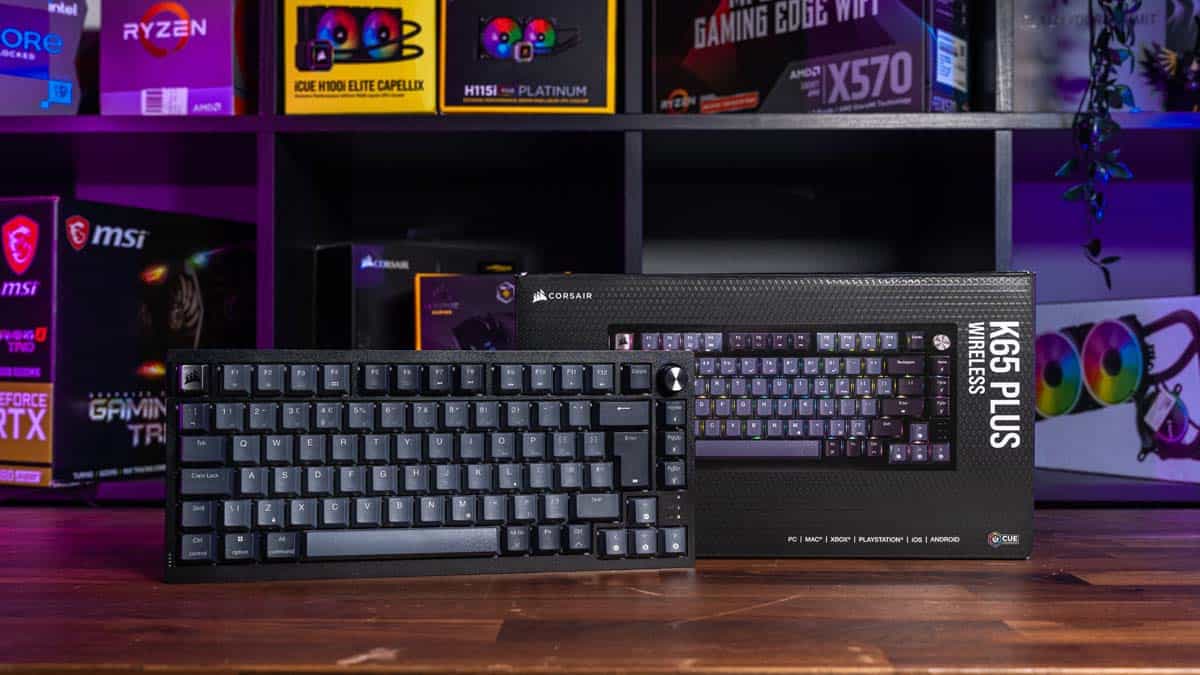

We tested the latest Corsair K65 Pro mechanical keyboard – a customizable board designed for gamers but also fantastic for typing Updated: Feb 26, 2024 1:27 pm WePC is reader-supported. When you buy through links on our site, we may earn an affiliate commission. Prices subject to change. Learn more Table of Contents Table of Contents The Corsair K65 Plus is a compact wireless keyboard that comes with hot-swappable Corsair Red MLX Linear switches. The brand has positioned this board in-between the more premium customizable keyboards on the market and more mid-range gaming models; in terms of price, features, and overall quality. We’ve been impressed with some of the company’s recent entries that have similarly tried to strike a balance between quality and price, such as the K70 Core, so were excited to get our hands on this latest entry in the large Corsair gaming keyboard roster to see how it measures up. Was it worthy of inclusion in our best gaming keyboard guide? Let’s find out. Pros A great typing experience Smooth, pre-lubed switches Hot-swappable switches Responsive, low-latency wireless connection Great battery life iCUE software works well Cons No key backlighting Singleshot keycaps No wrist-rest Design & Features The Corsair K65 Plus is a 75% size, 81-key, wireless keyboard that can utilize either a 2.4GHz wireless connection, a Bluetooth connection, or the included USB 3.0 Type-A cable if you so wish. Like many other recent Corsair models, it comes with a customizable multimedia knob (in the rotary dial style) on the top-right. The 75% size retains the function keys across the top of the board and the full-sized arrow keys in the bottom right (unlike the smaller 60% layout) but loses the dedicated Print Screen, Screen Lock, Pause, Insert, and End keys that you get in a TKL layout – it’s becoming an increasingly popular middle ground between the two. 2.4GHz w/dongle, Bluetooth, USB 3.0 Type-A You don’t get the dedicated media playback buttons on this board like you do on another 75% competitor the Razer BlackWidow V4, however, you still have these options by using the Fn command key. Most keys have sub-legends on them denoting the default secondary functions which lights up when you press the Fn key. The arrow keys on the bottom right for instance have the secondary functions of volume, RGB, zoom, and page scroll bound to them by default, which are denoted on the keycaps, although these can be reprogrammed should you wish. The programmable knob can be set to perform functions such as volume control, page scrolling etc. Several of the keys (e.g. Ctrl, Windows, Alt) also have Mac sub-legends on them too, as the keyboard has a dedicated Win/Mac layout switch that you can use to alternate between the two layout styles: this is a welcome, but typically infrequent inclusion in a gaming keyboard, and speaks to the quality of the device overall as a keyboard for typing. Besides this, you get a switch that alternates between Bluetooth/3-way-powered connection/2.4GHz wireless, plus a storage slot with the connecting dongle inside, a USB-C charging port, and a dedicated on/off lighting button along the side of the board. The switches that come with the board are Corsair’s own-brand Linear Red switches, which have 4mm total travel, a relatively high actuation point (for a mechanical board), and a non-tactile keypress with no bump. As it’s a hot-swappable keyboard though, you can remove these switches should you wish and replace them with your preferred model using the included tool, though as we will discuss below the standard switches are pretty damn good. The wireless and wired connections have a 1,000Hz polling rate ensuring nice and low latency – it’s not the fastest out there but for anyone who’s not the most dedicated competitive gamer it’s plenty. The body of the keyboard is plastic though it does have steel plate on the bottom which adds to the weight a fair bit – at 918g it’s not as light as some other boards of the same size as a result. The whole thing does feel pretty sturdy and well-made though. In terms of aesthetics it looks decent, though doesn’t have the wow factor of the more premium offerings; you can obviously swap out the keycaps though for something more visually impressive should you wish. Speaking of the keycaps, they are only single-shot dye-sublimated rather than the more durable double-shot you’d find in more premium boards, which is fine for most users although it is one of the ways in which Corsair appears to have cut costs relative to the more premium offerings available in this space. Previous Next Price At the time of writing, the MSRP of the Corsair K65 Plus is priced at an MSRP of $159.99 £149.99, which is much cheaper than the high-end customizable boards in this space like the ASUS Azoth ($250.00 / $250.00), though obviously, it’s by no means a budget board. As stated the quality is not quite up there with the true premium offerings, but considering what you do get it’s pretty decent value and an interesting price point within the wider market. Performance Our experience using the K65 Plus with the standard Corsair MLX Red linear switches was great, indeed, the smooth as-silk keypresses make it a solid gaming keyboard but create an even better typing experience. The pre-lubed switches give minimal rattle, but provide a satisfying clack, whilst not being too loud thanks to the dual-layered shock-absorbing design within the board, which is also found in the K70 Core. Indeed the typing experience is very similar overall to the K70 Core, coming as it does with the same switches, but obviously with the significant benefit of customization on the K65 Plus meaning you can change them out for alternative switches should you wish. The extendable keyboard feet are pretty solid and grippy and gave good purchase. We did find ourselves wishing for a wrist rest at certain points: given the steeper profile of the keyboard (common to most mechanical options) requires you to elevate your hands, putting downward pressure onto your wrists. That being said, it’s fairly uncommon to see 75% boards with wrist rests included, as the whole point of this size is to minimize the profile, so this isn’t much of a criticism, but it’s something to be aware of. The lack of key backlighting does (as expected), make it harder to type in the dark if you’re not a touch-typing pro; although this is similar to many enthusiast/boutique boards, it does hinder it somewhat as a gaming keyboard when you might want a more dimly lit environment and want maximum legibility for speed of key-identification. The board has full Corsair iCUE Software integration, which is one of the better bits of peripheral software out there (although it doesn’t have a dedicated switch to open it like you’ll find on the larger Corsair boards) As with most Corsair products, RGB customization is extensive and there’s a lot you can do with effects and layers within the software. The battery life was also solid – you can expect up to around 40 hours of usage from this 4,200mAh before you need to recharge it, and the battery-saving options within the iCUE software can help you effectively extend this.





